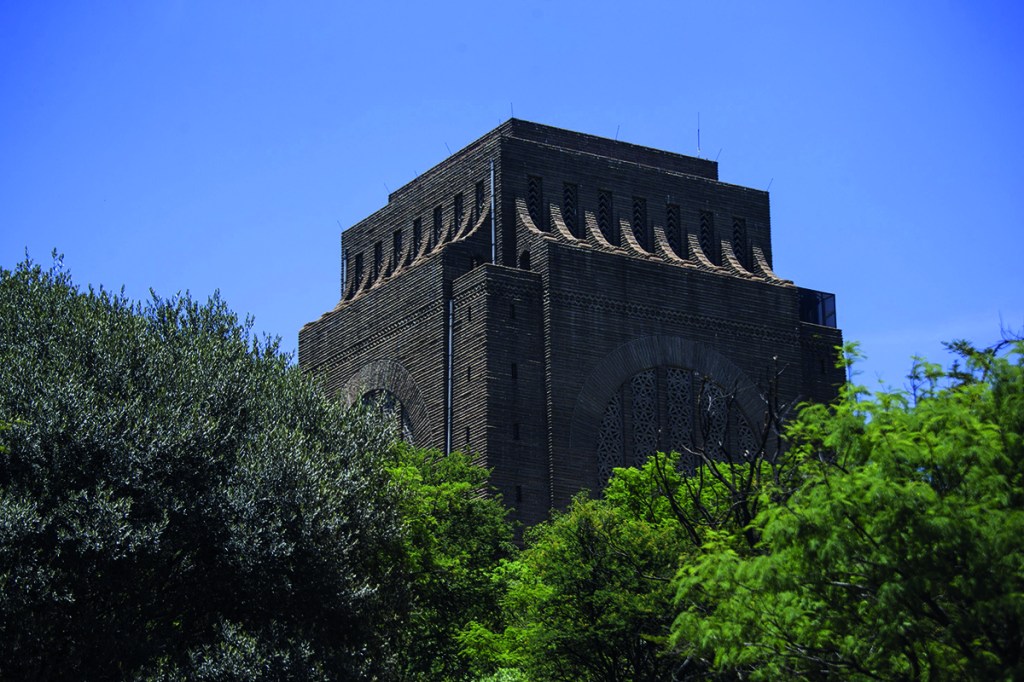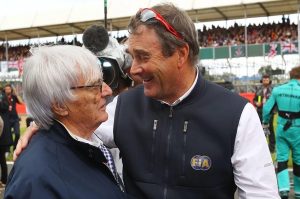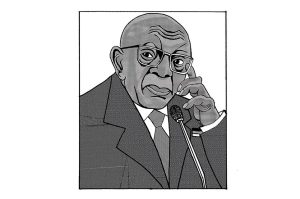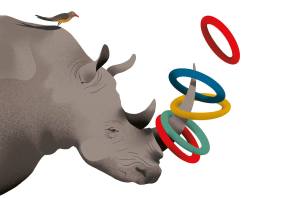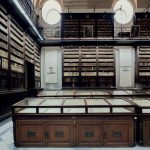The Voortrekker Monument sits on a hill on the outskirts of Pretoria, South Africa’s administrative capital. During apartheid (‘apartness’) this brooding tower symbolized the Afrikaners’ belief in their manifest destiny and journey to self-empowerment. The place, whose name means ‘Great Trekker’, was popular with school groups, politicians and the armed services. Today it is well maintained but feels forlorn. It is an embarrassing reminder of the past.
To get there is a short drive along the highway from Sandton, the northern suburban city which has largely replaced Johannesburg’s decaying central business district. The monument was opened in 1938 and commemorates the northward migration of the Afrikaner people around 100 years earlier, away from British colonial control. The visitor approaches through a long, looping drive up the hillside, towards a 130-foot-high square tower of gray granite. Each side has a huge arched window of yellow glass. The bulky, somber building evokes mixed impressions: a castle keep, a World War One mausoleum, a municipal crematorium. Surrounding the monument is a circular wall designed like a laager, a reminder of how the Voortrekkers drew their ox-wagons together in a protective huddle when fighting the tribal peoples whose territories they were invading.
On the day that we visited, staff outnumbered tourists. A party of five bewildered-looking Chinese people departed as we arrived. An English-speaking couple were being shown around by a guide. Apart from them, we were the only visitors for the next hour, dwarfed by its soaring space.
Once inside, the visitor’s eye falls on a marble frieze of 27 bas-relief panels running round the lower wall. We see the courage and determination of the Voortrekkers as they lash their oxen onwards, negotiate perilous mountain passes and defend themselves against attacks. In one of the panels, a woman pleads for the life of her children to a Zulu warrior who is about to spear them.
It is surprising that in the new South Africa, the panels are presented without comment. There seems to be no attempt to bring a present-day understanding to bear on this controversial episode in South African history. The same dilemma haunts not only the monument but the country: how to honor the contribution of the Afrikaners in the birth of the nation while also coming to terms with their role in apartheid?
These are troubled times for the Afrikaners. The burden of the memory of apartheid falls heavily on them, although it had the tacit support (and vote) of many English-speaking whites. But Afrikaners relied more than English speakers on a privileged job protection that is long gone. In an economy that favors black economic empowerment, Afrikaners now struggle to find their footing. Poor whites are among the beggars at what South Africa calls ‘robots’ (traffic lights). At one I gave 20 Rands (about $1.30) to a young white man. ‘Baie dankie, oom,’ he said, pathetically grateful for this small amount. ‘Many thanks, uncle.’
[special_offer]
These are also troubled times also for the nation as a whole. At the Voortrekker Monument, an elevator takes you up to a roof terrace offering a panoramic view of Pretoria. Here sits the administration which cannot keep the country’s lights on. The muddle and corruption of 24 years of ANC government has been cruelly exposed in the lack of forward planning for electricity generation. As a result, there is euphemistically named ‘load shedding’ almost daily for between two and four hours. The power cuts add more pressure on an economy which is already struggling.
The visitor to the Voortrekker Monument encounters a large circular opening in the middle and looks down at a cenotaph, a symbolic tomb remembering Piet Retief and other Voortrekker leaders. Each year on December 16, the sun shines through an aperture in the domed roof, and a ray falls on the tomb. On it are carved the words ‘Ons vir jou, SuidAfrika’, commemorating a vow for unity on December 16, 1838 made by a trek group just before a battle with the Zulus. The words mean ‘We are for you, South Africa,’ or, more poetically, ‘Together, for South Africa.’ A similar unity in adversity is now needed by the whole country.
December 16 has been a public holiday since the founding of the Union of South Africa in 1910. In 1995 the ANC government changed the name from ‘Day of the Covenant’ to ‘Day of Reconciliation’, as a move towards healing the wounds of apartheid. The Voortrekker Monument awaits a similar creative spirit, one that will make the place a symbol of national unity, even if that unity remains a work in progress. Meanwhile, the sun still shines on South Africa. In the Voortrekker Monument’s pleasant picnic area, or under the café loggia, the visitor can ponder how the past is never entirely the past.
This article is in The Spectator’s August 2020 US edition. Subscribe here to get yours.
